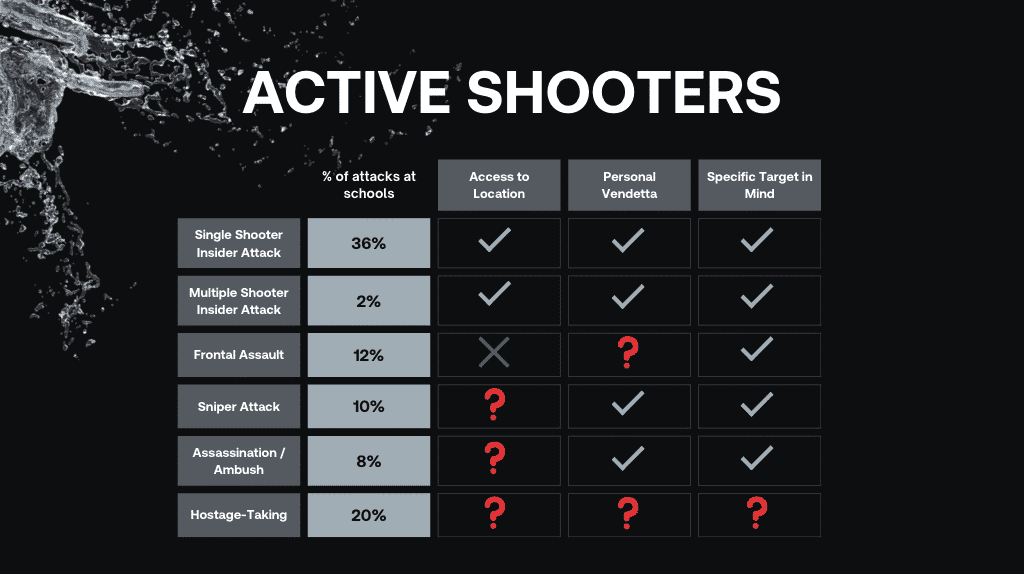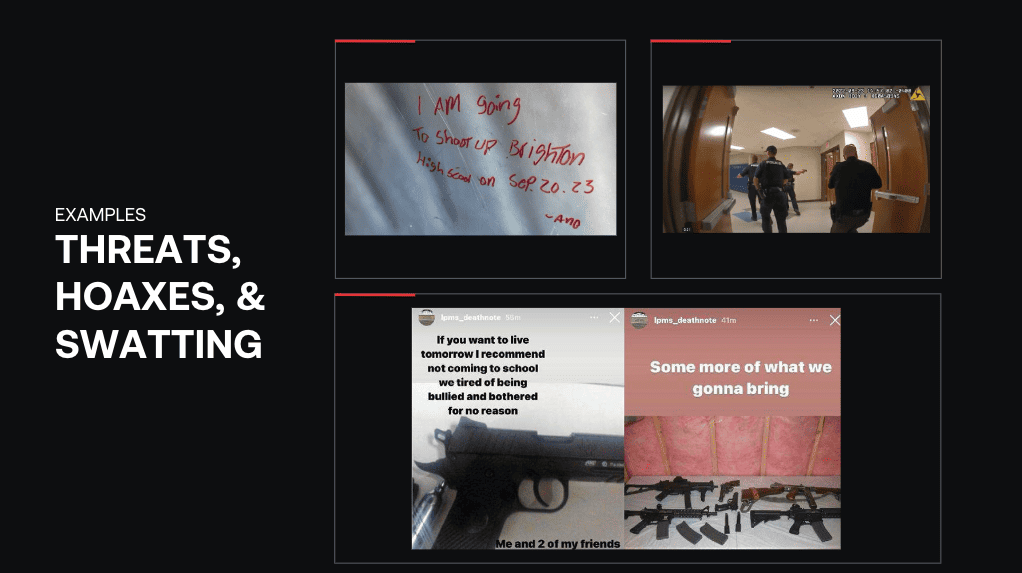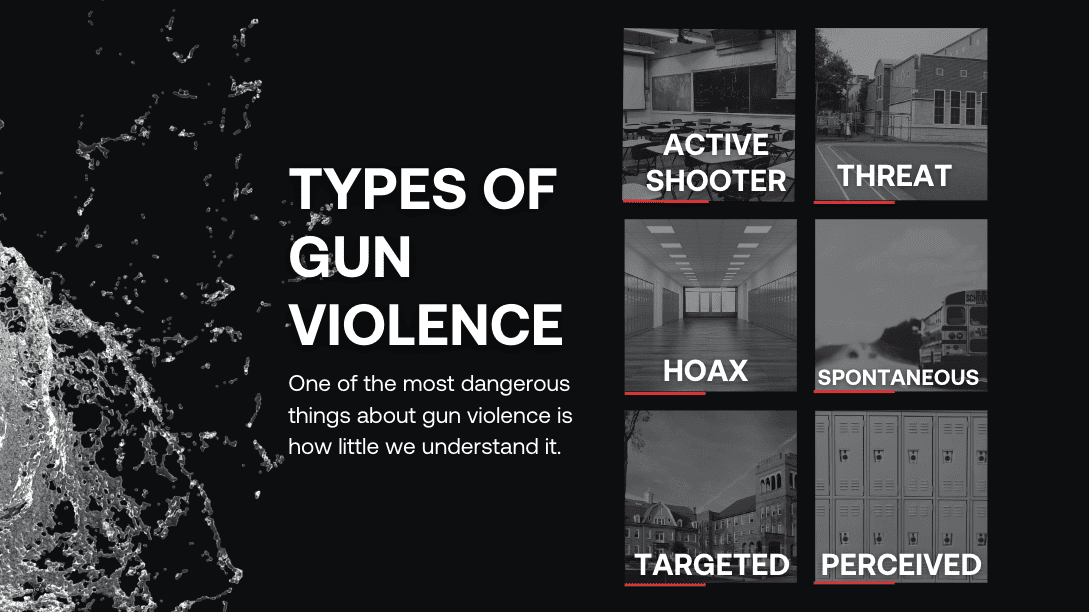Gun Violence at Our Schools—Complex and Catastrophic
During a recent webinar, David Riedman, industry leading gun violence expert and Director of Research Content for ZeroEyes, and Erin Acheson, VP of Marketing and gun violence survivor, sat down to discuss the impact of gun violence in education.
Part of an in-depth series of research into the variety of ways individuals and entire communities are affected by violence, details around:
- Gun violence categories, including the difference between types of active shooters, spontaneous, and targeted violence.
- Security measure efficacy for gun violence types
- Costs and considerations for various layers of security often considered
Varieties of gun violence in education
Schools, whether K-12 or universities, are susceptible to unique types of violence. While basic gun violence types span all environments, schools tend to see different types of perpetrators and concentrations of violence types.
The four main types of gun violence that impact school environments include:
- Active Shooter Incidents
- Threats
- Hoaxes and “Swatting”
- Perceived Violence
Active Shooter Incidents
The most frequently reported on and feared event—an active shooter on premises. A person (or persons) with a gun is present on campus or at a school event. These are every parent, faculty, staff, and student’s fear.
They may be in the parking lot, at a stadium, or inside a classroom when they are discovered, but they have made it to the premises with a gun. The gun may be legally or illegally owned. In most instances this does not matter as firearms are prohibited on almost every campus, and discharging the weapon immediately results in a crime whether this is a victim or not.
But even these incidents have variations that are extremely important.
Active shooter types vary based on:
- Access to the premises
- Motive
- Target(s)
Because there are so many kinds of active shooter situations, school environments and the associated law enforcement teams have to know how to handle each situation differently.
Active Shooter Types
- Single Shooter Insider Attack. Someone with knowledge of the facility who can bypass security or access the premises. Typically the focus of a grievance about a person at the location or symbolic grievance to the location.
- Multiple Shooter Insider Attack. Carried out by a group of people, with at least one having knowledge of the premises. Most are aligned around specific targets at the location.
- Frontal Assault. A raid on a target that the shooter(s) does not have permission to enter. This can be former students or staff members, people from a neighboring school, etc.
- Sniper Attack. Someone beyond the boundaries of the campus firing onto the premises. Typically into crowded parking lots, school entryways, bus loading zones, and athletic or event lines.
- Assassination / Ambush. The targeted killing of a person or persons because the shooter knows their whereabouts.
- Hostage-taking. Holding a person or persons against their will for personal or financial gain, or grievances.

Spontaneous Shootings and Targeted Gun Violence
Spontaneous shootings and targeted gun violence are not active shooter situations, but they’re often mistaken for them.
Hearing gunfire makes people panic. But immediately assuming that it’s an active shooter is misleading and has negative, and sometimes dangerous, consequences.
First, let’s define what each of these are, and then discuss the consequences.
Spontaneous Shooting
Spontaneous shootings are usually the result of an escalation of a fight. For example, two people begin to argue, then a physical altercation begins. As it escalates, someone may pull a gun they have or a family member or friend who is a bystander may draw a weapon and fire.
This is not an active shooter, because the shooter does not intend to shoot someone prior to the altercation, nor do they plan to continue shooting following that exact moment.
Targeted Gun Violence
Targeted gun violence, including domestic disputes, a disgruntled employee killing a supervisor, or other forms of murder in a public place are also not active shooters. In these instances, someone has a specific person that they plan to kill and no more.
At times, people who plan targeted gun violence attacks do become active shooters if they find themselves cornered or feel others are getting in their way.
Threats, Hoaxes and Swatting
Many people think threats and hoaxes are the same thing. They are very different and need to be addressed differently.

Threats
Threats and hoaxes are often confused. Threats occur when someone has a real intent to harm another person, persons, or property. The threat may have detailed planning and forethought or may have been made in the heat of the moment. Either way, threats are the result of intent and ability to carry out a shooting event.
Hoaxes and “Swatting”
Hoaxes and swatting issues differ from threats in the fact that they do not have real intent to follow through on a shooting. Most hoaxes are the result of students at the school, neighboring school, or in the community attempting to disrupt the normal school day. This can happen due to bullying, to get out of a test or assignment, peer pressure or “dares”, and a variety of other causes.
Swatting’s goal is to get authorities, particularly a SWAT team, to respond to an address. Many swatting instances use caller ID spoofing, voice altering software or devices, and even computer-generated calling. Some calls even come from outside of the country and have federal government involvement. There are thousands of cases of swatting already reported this year, including an instance in Massachusetts where 30 separate schools experienced swatting calls in a single day.
While they aren’t “active shooter” situations, the results can still be extreme. When hoaxes and swatting occur, the impact includes:
- School authorities and administrators get involved. That means time away from other activities and a series of protocols that are disruptive.
- Law enforcement, sometimes several branches including local, state and federal, are required. Hundreds of thousands of taxpayer dollars are used. Other crimes or issues are put on the back burner. Public areas may be closed down for hours, possibly days.
- Students, faculty, and staff are upset. Their day is disrupted, they lose valuable education time during the incident as well as for days following as anxiety continues. Fear causes loss of sleep, focus issues, behavioral issues, and absenteeism.
- Parents panic. They may pull their children out of class or the school altogether. Especially if they believe the school is not doing enough to create a safe space. They may demand action, remove their child from extracurricular activities, or try to control the situation themselves.
The toll is emotional, physical, and financial—even when “nothing happens.”
That brings us to perceived gun violence.
Perceived Gun Violence
Perceived violence is not normally considered an issue, but it should be. What is perceived violence? It’s what happens when we hear about gun violence and issues so frequently that we cultivate feelings of fear, anger, or anxiety. These problems disrupt routines, cause people to act in ways they wouldn’t normally, or to feel suspicious of people we would usually trust.
Perceived violence can lead to absenteeism from students and faculty, loss of sleep and focus, avoidance of activities including extracurricular experiences and sports, and in the worst cases, bringing weapons to campus to “protect yourself.”
Perceived violence escalates when we hear about issues on other campuses, even in locations that aren’t schools. The loss of secure spaces has a detrimental effect on everything from recruitment and retention of students and teachers, to funding and donor or sponsorship issues.
What Can You Do About Gun Violence at School?
Gun violence in our schools, activities, athletic events, and communities has an impact that is long-standing and multi-faceted. Our approach to it must also be multi-faceted, addressing the issues from several sides and ensuring we have looked at all the angles.
After seeing the several attack types, issues caused by threats, hoaxes, and swatting, and learning the difference between active shooters and other forms of gun violence—it’s clear that not all safety measures are useful against each option. In our next event series, we’ll discuss in depth the types of issues and the best ways to combat them on your campus.
Watch our most recent webinar to see an overview of safety measures including metal detectors, bulletproof glass, armed guards, and gun detection software—and how they stack up against the various attack types.
Additional Resources:

